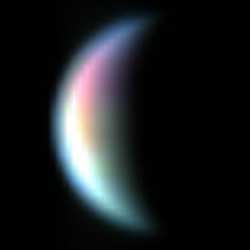
Rosetta’s view of Earth, taken during its March 2005 flyby. Image credit: ESA. Click to enlarge.
ESA?s comet chaser mission Rosetta took infrared and visible images of Earth and the Moon, during the Earth fly-by of 4/5 March 2005 while on its way to Comet 67P/Churyumov-Gerasimenko.
These images, now processed, are part of the first scientific data obtained by Rosetta. ?The Earth fly-by represented the first real chance to calibrate and validate the performance of the Rosetta?s instruments on a real space object, to make sure everything works fine at the final target,? said Angioletta Coradini, Principal Investigator for the Visible and Infrared Thermal Imaging Spectrometer (VIRTIS) instrument.
?Although we were just calibrating VIRTIS during the Earth fly-by last month, we obtained images of Earth and the Moon which have a high scientific content,? she added.
On 4 and 5 March, before closest approach to Earth and from a distance of 400 000 kilometres from our Moon, Rosetta?s VIRTIS took these images with high resolution in visible and infrared light. In these images, only a small portion of the Moon surface was illuminated (between 19% and 32%).
The spectral analysis (chemical ?finger-printing?) gives indications of the mineralogical differences between highlands and ?seas? or ?maria?. For instance, it was possible to see marked differences in the abundance of two kinds of rocks known as pyroxene and olivine.
On 5 March, after the closest approach to Earth, VIRTIS then took a series of high-resolution images of our planet in visible and infrared light from a distance of 250 000 kilometres. Only 49% of the Earth surface was visible from Rosetta.
Once at Comet 67P/Churyumov-Gerasimenko in 2014, VIRTIS will be used to determine the composition and the nature of the solid nucleus and the gases present in the comet?s coma.
In combination with the other Rosetta instruments, it will also help the selection of the ?touchdown? site for the Rosetta lander Philae.
Before then, Rosetta will make more cosmic loops to reach the comet, and its instruments will collect new data about planets, asteroids and comets. The next encounter with Earth is planned for November 2007.
VIRTIS as been developed by a large consortium of European scientists, with major contribution by Italy, France and Germany.
Original Source: ESA News Release
